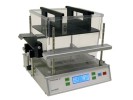Authors
F. Forcheron, P. Abdallah, A. Basset, P. del Carmine, G. Haffar et al.
Lab
INSERM ERI 22 EA 4173, Faculté Rockefeller, Lyon, France.
Journal
Obesity (Silver Spring)
Abstract
No specific treatment for nonalcoholic hepatic fatty liver disease has been defined. We followed the spontaneous evolution of liver steatosis and tested the therapeutic usefulness of metformin and fenofibrate in a model of steatosis, the Zucker diabetic fatty (ZDF) rat. ZDF and control rats were studied at 7, 14, and 21 weeks. After initial study at 7 weeks, ZDF rats received no treatment, metformin or fenofibrate until studies at 14 or 21 weeks. ZDF rats were obese, hypertriglyceridemic, insulin resistant at 7 weeks, type 2 diabetic at 14, diabetic with insulin deficiency at 21. They had steatosis at 7 weeks with increased hepatic expression and activity of lipogenesis. Steatosis was unchanged at 14 and 21 weeks despite lower expression and activity of lipogenesis. Metformin and fenofibrate did not modify energy intake or expenditure or the evolution of diabetes. Both compounds decreased plasma triacylglycerol (TAG) concentrations. Hepatic TAG content was reduced by fenofibrate at 14 and 21 weeks but only at 21 weeks by metformin. Metformin had no significant effects on the expression in liver of genes of fatty acids metabolism. The beneficial effect of fenofibrate occurred despite increased expression of genes involved in the uptake and activation of fatty acids. Acyl-CoA oxidase (ACO) and carnitine palmitoyltransferase I (CPTI) mRNA levels were increased by fenofibrate showing evidence of increased lipid oxidation. To conclude, metformin had only moderate effects on liver steatosis. The effects of fenofibrate was more marked but remained mild.
BIOSEB Instruments Used:
OXYLET, Indirect Calorimeter (OXYLET)

 Pain - Thermal Allodynia / Hyperalgesia
Pain - Thermal Allodynia / Hyperalgesia Pain - Spontaneous Pain - Postural Deficit
Pain - Spontaneous Pain - Postural Deficit Pain - Mechanical Allodynia / Hyperalgesia
Pain - Mechanical Allodynia / Hyperalgesia Learning/Memory - Attention - Addiction
Learning/Memory - Attention - Addiction Physiology & Respiratory Research
Physiology & Respiratory Research
 Pain
Pain Central Nervous System (CNS)
Central Nervous System (CNS) Neurodegeneration
Neurodegeneration Sensory system
Sensory system Motor control
Motor control Mood Disorders
Mood Disorders Other disorders
Other disorders Muscular system
Muscular system Joints
Joints Metabolism
Metabolism Cross-disciplinary subjects
Cross-disciplinary subjects Preclinical studies and opioids: role in crisis management in the United States
Preclinical studies and opioids: role in crisis management in the United States 